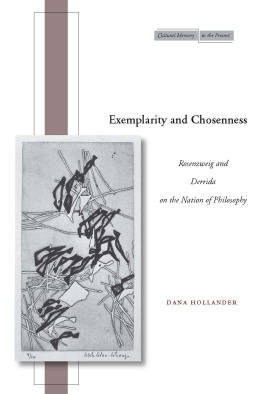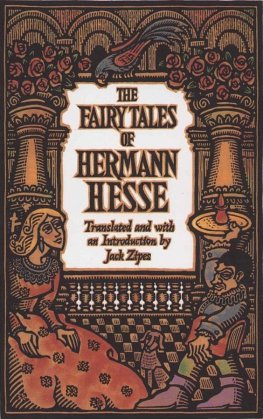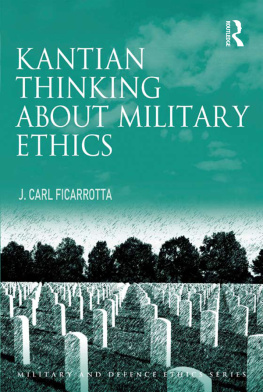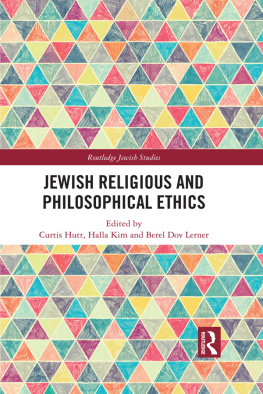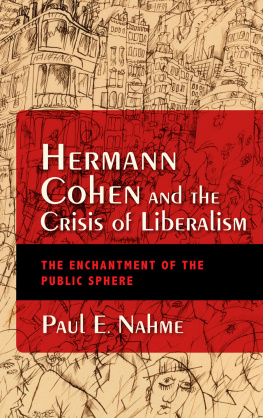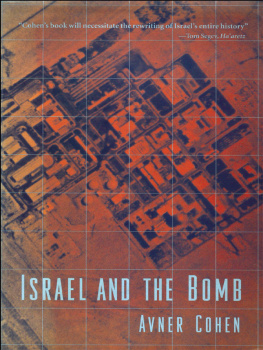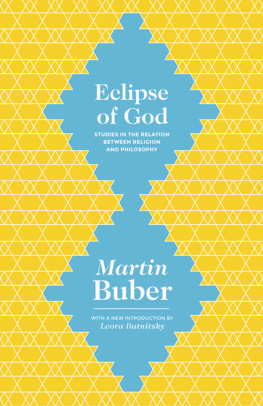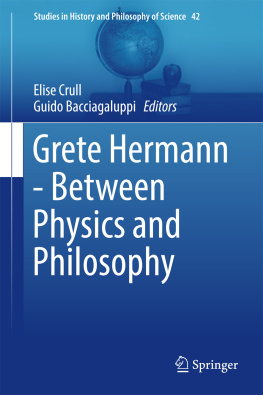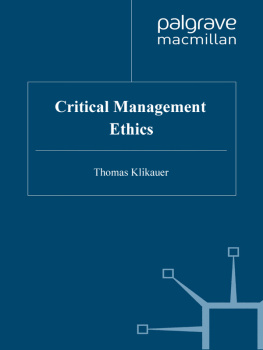Landmarks

ETHICS OUT OF LAW
DANA HOLLANDER
Ethics Out of Law
Hermann Cohen and the Neighbor
UNIVERSITY OF TORONTO PRESS
Toronto Buffalo London
University of Toronto Press 2021
Toronto Buffalo London
utorontopress.com
Printed in the U.S.A.
ISBN 978-1-4875-0624-7 (cloth) ISBN 978-1-4875-3368-7 (EPUB)
ISBN 978-1-4875-3367-0 (PDF)
Library and Archives Canada Cataloguing in Publication
Title: Ethics out of law : Hermann Cohen and the neighbor / Dana Hollander.
Names: Hollander, Dana, author.
Description: Includes bibliographical references and index.
Identifiers: Canadiana (print) 20200307967 | Canadiana (ebook) 20200307991 | ISBN 9781487506247 (hardcover) | ISBN 9781487533687 (EPUB) | ISBN 9781487533670 (PDF)
Subjects: LCSH: Cohen, Hermann, 18421918. | LCSH: Jewish philosophy 19th century. | LCSH: Jewish ethics Philosophy. | LCSH: Law and ethics. | LCSH: Law Philosophy. | LCSH: Ethics Philosophy.
Classification: LCC B3216.C74 H65 2021 | DDC 296.3/6 dc23
This book has been published with the help of a grant from the Federation for the Humanities and Social Sciences, through the Awards to Scholarly Publications Program, using funds provided by the Social Sciences and Humanities Research Council of Canada.
University of Toronto Press acknowledges the financial assistance to its publishing program of the Canada Council for the Arts and the Ontario Arts Council, an agency of the Government of Ontario.

Contents
To understand Hermann Cohens systematic philosophy in conjunction with his writings on Judaism has been an interest of mine for many years, beginning with the work that went into a chapter of my first book (Exemplarity and Chosenness: Rosenzweig and Derrida on the Nation of Philosophy [2008]) that looked at Cohen as a prime influence on Franz Rosenzweigs Star of Redemption.
My idea to work on this topic in a sustained fashion began to take shape thanks to a most stimulating year I spent as a postdoctoral fellow with the UCLA Mellon Sawyer Seminar on The Ethics of the Neighbor, directed by Kenneth Reinhard. Subsequent stages of the project were enabled by a Standard Research Grant from Canadas Social Sciences and Humanities Research Council (SSHRC) and a fellowship from the Alexander von Humboldt Foundation. That fellowship allowed me to spend eighteen months at the Zentrum fr Literatur- und Kulturforschung (ZfL, Center for Literary and Cultural Research) in Berlin, leading to a summer stay funded by one of the ZfLs own fellowships. I am most grateful to Kenneth Reinhard and Martin Treml, my hosts at UCLA and the ZfL, respectively, as well as to other colleagues and staff at both institutions, for providing such nourishing environments in which my thinking toward this book began to develop. Martins and Kens intellectual partnership allowed for many fruitful exchanges during my stays, and enabled us to collaborate on colloquia and workshops. My work on the book was further supported by two research leaves granted by McMaster University, and by the Canada Research Chairs Program, which funded my position and research activities during my first five years at McMaster, when I held the Canada Research Chair in Modern Jewish Thought. Most recently, I was able to complete the manuscript thanks to a research stay at the Selma Stern Zentrum fr Jdische Studien (Center for Jewish Studies) Berlin-Brandenburg.
Many colleagues and friends encouraged my ongoing work toward this book by inviting me to share my work in progress at conferences, workshops, invited lectures and in edited volumes, with many fruitful discussions on those occasions. These include Stephan Steiner; Klaus-Peter Adam and Paul Mendes-Flohr; Liliana Feierstein; Norbert Waszek; Robert Yelle; Nitzan Lebovic and Daniel Weidner; Leora Batnitzky; Eric Dreff; Sergey Dolgopolski; Elad Lapidot and Ron Naiweld; Ino Augsberg and Karl-Heinz Ladeur; Paula Schwebel; Paul North, Paul Franks, and Eliyahu Stern; Jeffrey Bernstein; Randi Rashkover and Martin Kavka; John Ackerman; Myriam Bienenstock; Rabbi Michael Stroh; Rodolphe Gasch; Aaron W. Hughes and Elliot R. Wolfson; Leonard V. Kaplan; Martina Urban and Christian Wiese; Till van Rahden; Kevin Hart; and Michael Zank.
My work has been greatly sustained over the years by the enthusiasm, curiosity, and friendship of Antonio Calcagno, David L. Clark, Astrid Deuber-Mankowsky, Louis Greenspan (zl), Christoph Kasten, Rabbi Yonah Lavery-Yisrali, Gesine Palmer, Randi Rashkover, Eugene Sheppard, Rabbi Asher Turin (zl), and Arnd Wedemeyer.
I am grateful to Diane Perpich, Michael Morgan, Peter Fenves, and Michael Zank, who gave crucial support to my efforts to bring this work to publication. Roshaya Rodness provided invaluable research assistance and feedback on the manuscript at the final stages. Len Husband has been a wonderful and encouraging editor at University of Toronto Press. I am grateful to Jeff Tessier for allowing me to use his photography for the book cover.
I thank my partner, Nick Storch, and my daughters for the warmth of a home; and my mother, Vita Hollander, for her immeasurable, unwavering support of all my endeavors.

Lastly, I am most grateful to fellow Cohen scholar Christoph Kasten for instigating a daytrip to Hermann Cohens birthplace, the picturesque town Coswig (Anhalt) on the Elbe River, and to Rolf-Dieter Rediess, who welcomed us on behalf of the Coswig-based Cohen-Gesellschaft a society of citizens devoted to cultivating the legacy of this famous Jewish citizen of their town, and the worldly cultural heritage that his name evokes and who generously shared his knowledge of the topography of Cohens early life with us. This visit greatly sharpened my sense of the geographical, social and cultural-political spaces of Cohens thought. Standing in front of the empty paved lot at Domstrasse 6 on which the house had stood that served as both the Cohen family home and the Jewish community and school building (it had been senselessly razed by the authorities in 1982) a large gap in an otherwise intact row of historic houses we could glance in one direction toward the site, some houses away along the same narrow street, of the former synagogue (destroyed on Kristallnacht and subsequently demolished) where Hermanns father Gerson had served as a cantor. Looking down the street in the other direction, a few houses down from the Cohens old address, we faced the citys handsome abandoned castle at one time inhabited by a branch of the family of the Dukes of Anhalt, and in later decades used as a military hospital, then for many years as a prison (which also held political prisoners and was the site of executions), including under both the Nazi and GDR regimes, and most recently as a state archive.
Cohen was fond of describing his parental home and hometown, which he continued visiting up until his mothers death in 1873. A 1902 letter to Kurt Eisner, the socialist author and politician who had befriended Cohen while living in Marburg in the 1890s and who acknowledged him as a key intellectual influence, makes reference to a period during which Cohen worked, in the upper room of his parents house, on his book Kants Theorie der Erfahrung (submitted in 1871 as his Habilitation thesis). In honor of the philosophers sixtieth birthday, Eisner had sent a landscape painted by his wife, Lisbeth Eisner, depicting a view of Coswig. The couple had evidently traveled to Coswig in order to create the painting. Cohens letter acknowledging the gift as a tribute to his love of my German home [


